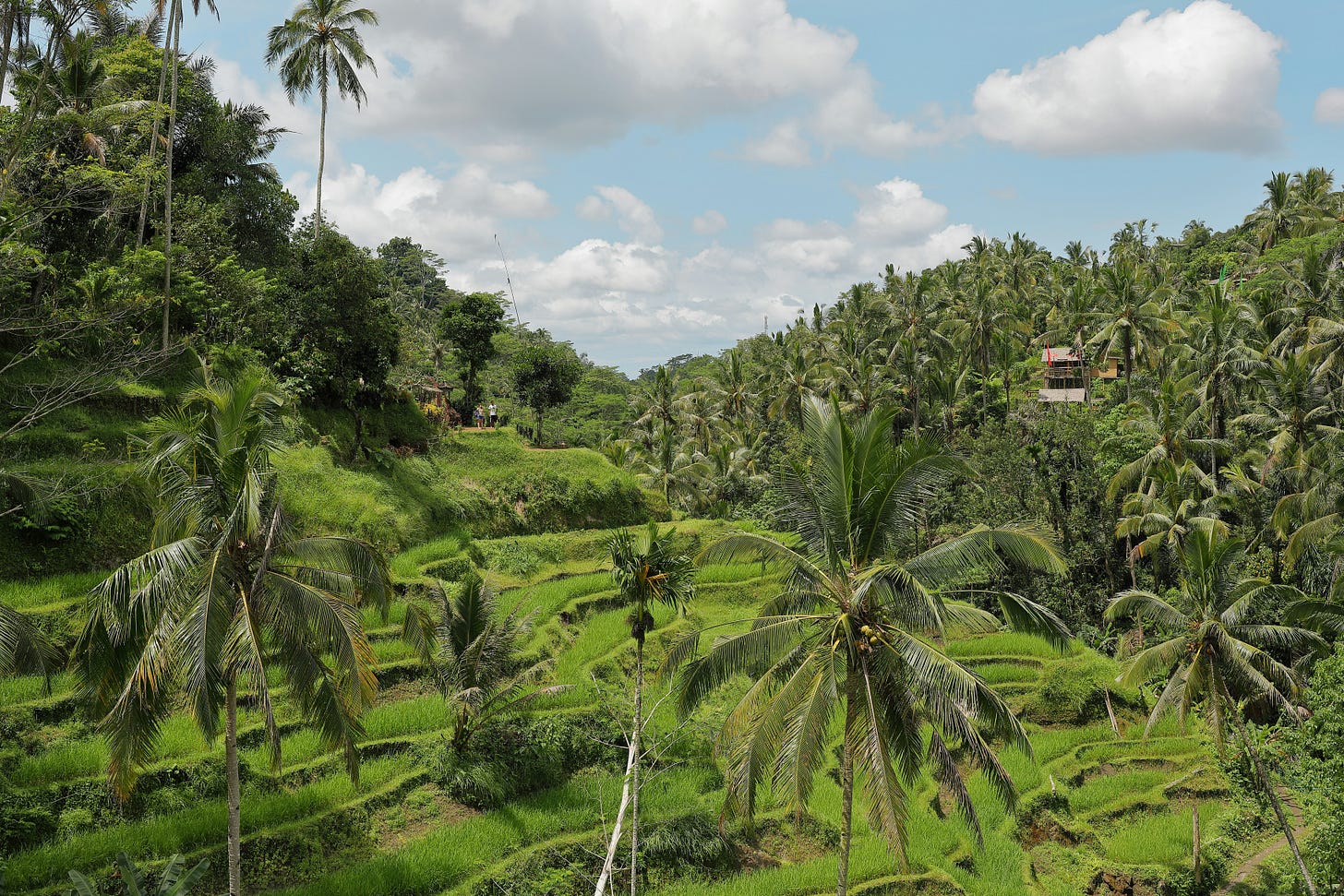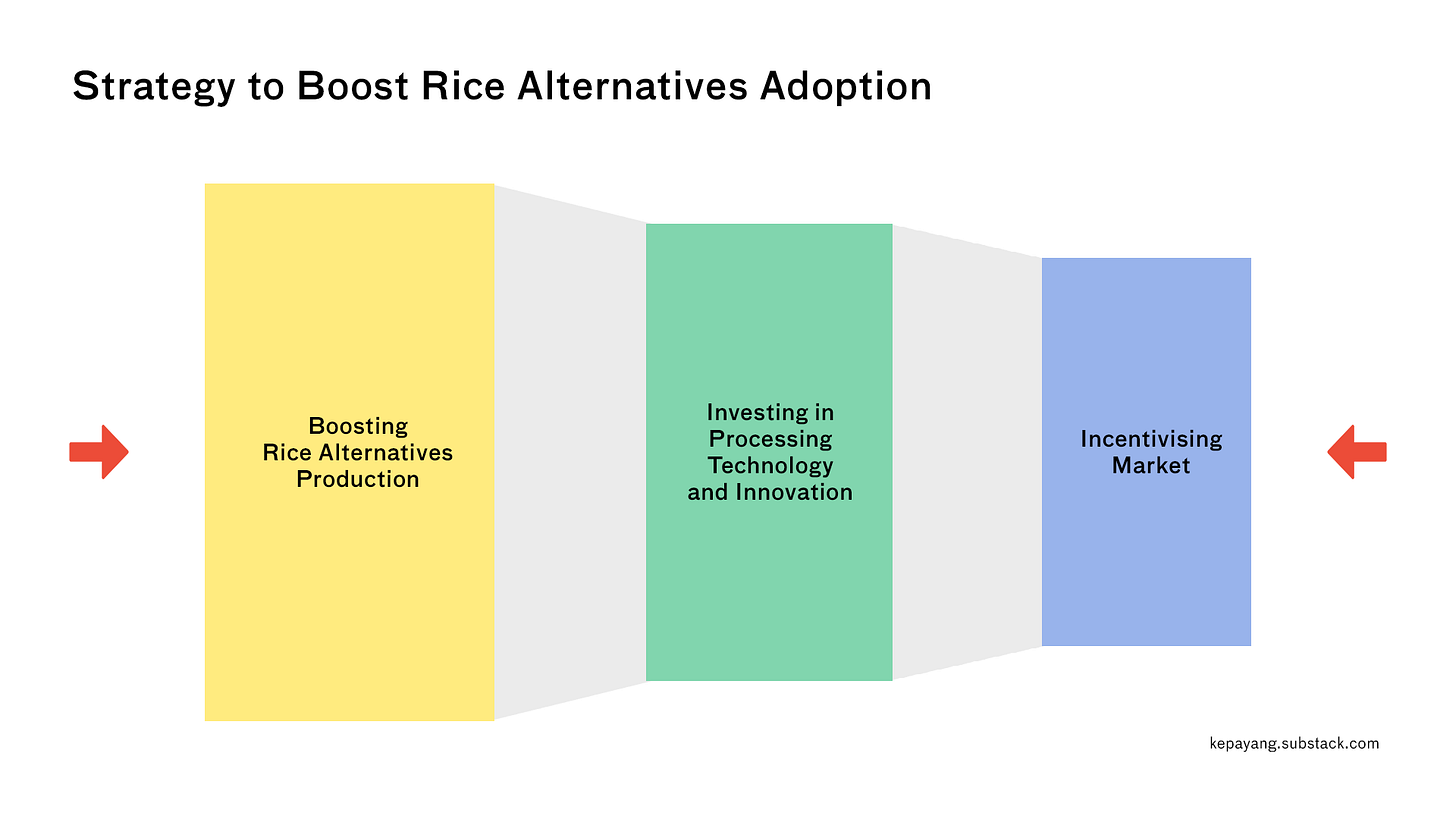All Hands on Deck to Cut Rice Dependency
Food News from Indonesia | Indonesians are eating more rice than they can grow, but Nusa Tenggara Timur and Sulawesi Utara might have some ideas.

Welcome to Kepayang’s first-ever edition of Food News from Indonesia, where I’ll sum up what’s been happening with our food scene in the last six months — plus a generous amount of my opinion. This first edition is a three-parter, which means you will have a new story every week throughout this August. That’s right, it’s the Independence Month spirit or whatever. 🇮🇩
To remind you, Indonesia is a huge country with thousands of islands and a skewed focus on Jawa and Bali. So, to keep things fair, I'll be highlighting food news from underrepresented regions. Last week, I covered a story from our westernmost province, Aceh, particularly on its recent ganja control actions. This week, we’re going to Nusa Tenggara Timur and Sulawesi Utara to discover their strategy for combating rice dependency. Enjoy!
Disclaimer: I’m not a journalist – though I wish I were. I’m just a writer with a passion for food, some self-taught research skills (mostly gathered from trips to the pasar and supermarket), and a desktop research proficiency. The information below comes from news sources I personally trust, and all opinions are entirely my own and don’t represent Kepayang’s views. Well, Kepayang is my personal newsletter, so you get the idea. Please take everything with a grain of salt, do your own research, and feel free to let me know if I’ve made a mistake.
As an Indonesian myself, I find it weird to hear that people are ditching rice when rice is life. I eat rice every day. I would even say that more than half of my meals would have rice in one form or another. White rice, congee, vermicelli noodles, kerupuk gendar (rice crackers), you name it. However, taking a few steps back to the Orde Baru (New Order, 1966-1998) era, we can easily see that rice has not always been the it girl.
The Orde Baru era marked a turning point in Indonesia’s rice production and distribution, especially after several setbacks during the Orde Lama era (Old Order, 1959-1966). With high-yielding rice varieties, superior fertilisers and pesticides, and improved farming infrastructure, rice production and distribution boomed, as well as the demand for more farmland. This leads to the need to open thousands of hectares of rice fields in regions outside Jawa, including Eastern Indonesia.
For most people in Jawa, eating rice is just part of everyday life, but in Eastern Indonesia, it wasn't always the go-to carb. They had plenty of cassava, sweet potatoes, and other tubers, so rice would naturally take the backseat. The expansion of rice production in Eastern Indonesia answered a couple of things; not only it helped us move towards self-sufficiency but it also helped to meet the rice demand from Javanese migrants who moved to Eastern Indonesia during the colonial period. Over time, both factors contributed to a slow shift in local diets, eventually leading to a dependency on rice.
Kepayang is free for now, so any engagements mean so much to support the platform’s growth. You can subscribe to get the newsletter sent directly to your email, like, comment, and share if you resonate with what I write.
Alternatively, you can buy me a coffee through my PayPal here: https://paypal.me/chalafabia - or if you’re based in Indonesia, you can send your donation through QRIS here (under the name Tamanan). Any amounts are welcomed and will directly contribute to sustaining this platform to cover expenses related to operations, research, writing, and marketing. ☕️
In the past ten years, Indonesia consistently imported huge amounts of rice from other countries. One of the reasons is due to the lack of rice supply. The amount of imported rice fluctuated from year to year, with occasional spikes such as those in 2012 and 2018. Unfortunately, the spike is back, and in 2023, we imported seven times more rice than in 2022 (Statistics Indonesia, 2024) – that’s a 600% plus increase!
If you notice, rice imports also seem to spike right before Indonesia's presidential election. I wonder why. But let's save that topic for another newsletter. Anyway, this shit is concerning, especially when we also have plenty amount of other types of food that we decided not to like.
The plan to lessen our dependency on rice has been discussed by the Indonesian government since the 1970s, but they were never serious about it. They kept saying how important it was. But remember, they also have this big rice production target. So while they kept promoting that diversifying our diet is beneficial, they also didn’t even bother to develop technology to process rice alternatives. It’s like that meme where a guy is dating that one girl — but has a secret crush on that other girl — and everyone knows that it’s not a secret.
Fortunately, in recent years, several new initiatives have emerged to reduce our rice dependency, addressing the issue at both national and local levels.
The first bit of good news came from Sumba Timur in Nusa Tenggara Timur province, where a 3,000-hectare farmland has recently been expanded to focus on sorghum production. If you didn’t know, sorghum is a type of grain native to Africa, that found its way to Indonesia by way of the Dutch when they colonised us. The focus on growing sorghum started in 2022 as a way to lessen our dependency on rice. By 2022, a total of 4,000+ hectares of sorghum fields were developed across Indonesia, with almost 80% being located in Nusa Tenggara Timur (2022).
Sorghum is also believed to be a superior produce, both from the farmer's and consumer’s perspective. As a crop, sorghum doesn’t need much water, and its selling points are competitive, if not, is higher than corn. As a source of carbs, sorghum is relatively high in fibre and low in sugar, making it safe for people with diabetes.
Unfortunately, while these benefits sound great on paper, the reality is that sorghum still isn’t popular among consumers, mainly because of its strong nutty taste and grainy texture. But with the expansion of sorghum plantations and more technological advancements in processing it, I can only hope that sorghum will become the next big thing.
The second piece of news comes from Minahasa Selatan in Sulawesi Utara province, where a new incentive program to promote rice alternatives has just been announced. In early August, the bupati (district chief/regent) of Minahasa Selatan introduced a program called Gemar Makang Makanan Pendamping Beras (which means "Enjoy Eating Rice Alternatives"), aimed at subsidising the prices of produce that can replace rice.
This program aims to strengthen food sovereignty in Minahasa Selatan, especially with the growing demand for rice. By partnering with local food producers, the local government is subsidising 20% of commodity prices by covering the producers' costs. This way, both producers and consumers will be benefited. The exact produce that will be subsidised hasn’t been confirmed yet, but hopefully, it will encourage people to rethink their rice consumption.
The first step to reducing our reliance on rice is to be aware of the available alternatives. While this may seem simple, it requires a joint effort at both the national and local levels. Ensuring a steady supply and processing it effectively and innovatively will make these products more accessible and appealing to the market. Additionally, providing incentives to buy these alternatives will encourage higher adoption. These initiatives are already being seen today and will hopefully inspire more in the future.
If you have any opinions, please let me know! And I’ll see you next week with a story from Maluku.
Other contents that I made recently:
🌱 Read the news on Aceh’s recent ganja control actions: here.
🔥 Read a whole ass essay on Indonesia’s hot sauce, Saus Sambal: here.
📖 Read about how recipes don’t and do matter at the same time: here
☕️ Read about the different coffee culture waves and how they are today: here.
🐈 Read my first literary review, on food representation in a short story: here.
🥤 Read this essay if you like sugary drinks: here.
🍞 Read an essay on Indonesia’s wheat dependency problem: here.
If you like today’s newsletter, please like and share it with your friends! Comment down below your thoughts and let me know if you have any other topics you want me to discuss. Until then, I’ll see you in two weeks!
Follow me everywhere:
TikTok: @berusahavegan
Kepayang’s Instagram: @readkepayang
Instagram: @menggemaskan
LinkedIn: Chalafabia Haris
Work with me: readkepayang@gmail.com









